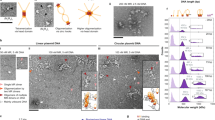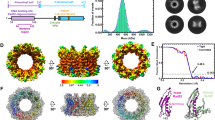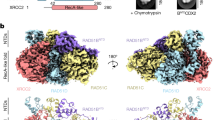Abstract
The Mre11 complex (Mre11, Rad50 and Xrs2 in Saccharomyces cerevisiae) influences diverse functions in the DNA damage response. The complex comprises the globular DNA-binding domain and the Rad50 hook domain, which are linked by a long and extended Rad50 coiled-coil domain. In this study, we constructed rad50 alleles encoding truncations of the coiled-coil domain to determine which Mre11 complex functions required the full length of the coils. These mutations abolished telomere maintenance and meiotic double-strand break (DSB) formation, and severely impaired homologous recombination, indicating a requirement for long-range action. Nonhomologous end joining, which is probably mediated by the globular domain of the Mre11 complex, was also severely impaired by alteration of the coiled-coil and hook domains, providing the first evidence of their influence on this process. These data show that functions of Mre11 complex are integrated by the coiled coils of Rad50.
This is a preview of subscription content, access via your institution
Access options
Subscribe to this journal
Receive 12 print issues and online access
$189.00 per year
only $15.75 per issue
Buy this article
- Purchase on Springer Link
- Instant access to full article PDF
Prices may be subject to local taxes which are calculated during checkout







Similar content being viewed by others
References
Stracker, T.H. & Petrini, J.H. The MRE11 complex: starting from the ends. Nat. Rev. Mol. Cell Biol. 12, 90–103 (2011).
Williams, R.S., Williams, J.S. & Tainer, J.A. Mre11-Rad50-Nbs1 is a keystone complex connecting DNA repair machinery, double-strand break signaling, and the chromatin template. Biochem. Cell Biol. 85, 509–520 (2007).
Paull, T.T. & Gellert, M. The 3′ to 5′ exonuclease activity of Mre 11 facilitates repair of DNA double-strand breaks. Mol. Cell 1, 969–979 (1998).
Bressan, D.A., Olivares, H.A., Nelms, B.E. & Petrini, J.H. Alteration of N-terminal phosphoesterase signature motifs inactivates Saccharomyces cerevisiae Mre11. Genetics 150, 591–600 (1998).
Bressan, D.A., Baxter, B.K. & Petrini, J.H. The Mre11-Rad50-Xrs2 protein complex facilitates homologous recombination-based double-strand break repair in Saccharomyces cerevisiae. Mol. Cell. Biol. 19, 7681–7687 (1999).
Moreau, S., Ferguson, J.R. & Symington, L.S. The nuclease activity of Mre11 is required for meiosis but not for mating type switching, end joining, or telomere maintenance. Mol. Cell. Biol. 19, 556–566 (1999).
González-Barrera, S., Cortes-Ledesma, F., Wellinger, R.E. & Aguilera, A. Equal sister chromatid exchange is a major mechanism of double-strand break repair in yeast. Mol. Cell 11, 1661–1671 (2003).
Hopfner, K.P. et al. The Rad50 zinc-hook is a structure joining Mre11 complexes in DNA recombination and repair. Nature 418, 562–566 (2002).
Hopfner, K.P., Putnam, C.D. & Tainer, J.A. DNA double-strand break repair from head to tail. Curr. Opin. Struct. Biol. 12, 115–122 (2002).
Wiltzius, J.J., Hohl, M., Fleming, J.C. & Petrini, J.H. The Rad50 hook domain is a critical determinant of Mre11 complex functions. Nat. Struct. Mol. Biol. 12, 403–407 (2005).
Williams, G.J., Lees-Miller, S.P. & Tainer, J.A. Mre11-Rad50-Nbs1 conformations and the control of sensing, signaling, and effector responses at DNA double-strand breaks. DNA Repair (Amst.) 9, 1299–1306 (2010).
Williams, R.S. et al. Mre11 dimers coordinate DNA end bridging and nuclease processing in double-strand-break repair. Cell 135, 97–109 (2008).
de Jager, M. et al. Differential arrangements of conserved building blocks among homologs of the Rad50/Mre11 DNA repair protein complex. J. Mol. Biol. 339, 937–949 (2004).
Moreno-Herrero, F. et al. Mesoscale conformational changes in the DNA-repair complex Rad50/Mre11/Nbs1 upon binding DNA. Nature 437, 440–443 (2005).
Chen, L., Trujillo, K., Ramos, W., Sung, P. & Tomkinson, A.E. Promotion of Dnl4-catalyzed DNA end-joining by the Rad50/Mre11/Xrs2 and Hdf1/Hdf2 complexes. Mol. Cell 8, 1105–1115 (2001).
de Jager, M. et al. Human Rad50/Mre11 is a flexible complex that can tether DNA ends. Mol. Cell 8, 1129–1135 (2001).
Trujillo, K.M. et al. Yeast xrs2 binds DNA and helps target rad50 and mre11 to DNA ends. J. Biol. Chem. 278, 48957–48964 (2003).
Chen, L. et al. Effect of amino acid substitutions in the rad50 ATP binding domain on DNA double strand break repair in yeast. J. Biol. Chem. 280, 2620–2627 (2005).
Costanzo, V., Paull, T., Gottesman, M. & Gautier, J. Mre11 assembles linear DNA fragments into DNA damage signaling complexes. PLoS Biol. 2, E110 (2004).
van der Linden, E., Sanchez, H., Kinoshita, E., Kanaar, R. & Wyman, C. RAD50 and NBS1 form a stable complex functional in DNA binding and tethering. Nucleic Acids Res. 37, 1580–1588 (2009).
van Noort, J. et al. The coiled-coil of the human Rad50 DNA repair protein contains specific segments of increased flexibility. Proc. Natl. Acad. Sci. USA 100, 7581–7586 (2003).
Uhlmann, F., Wernic, D., Poupart, M.A., Koonin, E.V. & Nasmyth, K. Cleavage of cohesin by the CD clan protease separin triggers anaphase in yeast. Cell 103, 375–386 (2000).
Anderson, D.E., Trujillo, K.M., Sung, P. & Erickson, H.P. Structure of the Rad50 x Mre11 DNA repair complex from Saccharomyces cerevisiae by electron microscopy. J. Biol. Chem. 276, 37027–37033 (2001).
Hopfner, K.P. et al. Structural biochemistry and interaction architecture of the DNA double-strand break repair Mre11 nuclease and Rad50-ATPase. Cell 105, 473–485 (2001).
Williams, G.J. et al. ABC ATPase signature helices in Rad50 link nucleotide state to Mre11 interface for DNA repair. Nat. Struct. Mol. Biol. 18, 423–431 (2011).
Lammens, K. et al. The Mre11:Rad50 structure shows an ATP-dependent molecular clamp in DNA double-strand break Repair. Cell 145, 54–66 (2011).
Lim, H.S., Kim, J.S., Park, Y.B., Gwon, G.H. & Cho, Y. Crystal structure of the Mre11-Rad50-ATP{gamma}S complex: understanding the interplay between Mre11 and Rad50. Genes Dev. 25, 1091–1104 (2011).
Hopfner, K.P. et al. Structural biology of Rad50 ATPase: ATP-driven conformational control in DNA double-strand break repair and the ABC-ATPase superfamily. Cell 101, 789–800 (2000).
Keeney, S. & Kleckner, N. Covalent protein-DNA complexes at the 5′ strand termini of meiosis-specific double-strand breaks in yeast. Proc. Natl. Acad. Sci. USA 92, 11274–11278 (1995).
Kadyk, L.C. & Hartwell, L.H. Sister chromatids are preferred over homologs as substrates for recombinational repair in Saccharomyces cerevisiae. Genetics 132, 387–402 (1992).
Cortés-Ledesma, F. & Aguilera, A. Double-strand breaks arising by replication through a nick are repaired by cohesin-dependent sister-chromatid exchange. EMBO Rep. 7, 919–926 (2006).
Ajimura, M., Leem, S.H. & Ogawa, H. Identification of new genes required for meiotic recombination in Saccharomyces cerevisiae. Genetics 133, 51–66 (1993).
Huang, K.N. & Symington, L.S. Mutation of the gene encoding protein kinase C 1 stimulates mitotic recombination in Saccharomyces cerevisiae. Mol. Cell. Biol. 14, 6039–6045 (1994).
Mozlin, A.M., Fung, C.W. & Symington, L.S. Role of the Saccharomyces cerevisiae Rad51 paralogs in sister chromatid recombination. Genetics 178, 113–126 (2008).
Moore, J.K. & Haber, J.E. Cell cycle and genetic requirements of two pathways of nonhomologous end-joining repair of double-strand breaks in Saccharomyces cerevisiae. Mol. Cell. Biol. 16, 2164–2173 (1996).
Boulton, S.J. & Jackson, S.P. Components of the Ku-dependent nonhomologous end-joining pathway are involved in telomeric length maintenance and telomeric silencing. EMBO J. 17, 1819–1828 (1998).
Lamarche, B.J., Orazio, N.I. & Weitzman, M.D. The MRN complex in double-strand break repair and telomere maintenance. FEBS Lett. 584, 3682–3695 (2010).
Tseng, S.F., Gabriel, A. & Teng, S.C. Proofreading activity of DNA polymerase Pol2 mediates 3′-end processing during nonhomologous end joining in yeast. PLoS Genet. 4, e1000060 (2008).
Hochwagen, A., Tham, W.H., Brar, G.A. & Amon, A. The FK506 binding protein Fpr3 counteracts protein phosphatase 1 to maintain meiotic recombination checkpoint activity. Cell 122, 861–873 (2005).
McVey, M. & Lee, S.E. MMEJ repair of double-strand breaks (director's cut): deleted sequences and alternative endings. Trends Genet. 24, 529–538 (2008).
Palmbos, P.L., Daley, J.M. & Wilson, T.E. Mutations of the Yku80 C terminus and Xrs2 FHA domain specifically block yeast nonhomologous end joining. Mol. Cell. Biol. 25, 10782–10790 (2005).
Matsuzaki, K., Shinohara, A. & Shinohara, M. Forkhead-associated domain of yeast Xrs2, a homolog of human Nbs1, promotes nonhomologous end joining through interaction with a ligase IV partner protein, Lif1. Genetics 179, 213–225 (2008).
Makarova, O., Kamberov, E. & Margolis, B. Generation of deletion and point mutations with one primer in a single cloning step. Biotechniques 29, 970–972 (2000).
Schiestl, R.H. & Gietz, R.D. High efficiency transformation of intact yeast cells using single stranded nucleic acids as a carrier. Curr. Genet. 16, 339–346 (1989).
Kim, H.S. et al. Functional interactions between Sae2 and the Mre11 complex. Genetics 178, 711–723 (2008).
Usui, T., Ogawa, H. & Petrini, J.H. A DNA damage response pathway controlled by Tel1 and the Mre11 complex. Mol. Cell. 7, 1255–1266 (2001).
Trujillo, K.M. & Sung, P. DNA structure-specific nuclease activities in the Saccharomyces cerevisiae Rad50–Mre11 complex. J. Biol. Chem. 276, 35458–35464 (2001).
Furuse, M. et al. Distinct roles of two separable in vitro activities of yeast mre11 in mitotic and meiotic recombination. EMBO J. 17, 6412–6425 (1998).
Murakami, H., Borde, V., Nicolas, A. & Keeney, S. Gel electrophoresis assays for analyzing DNA double-strand breaks in Saccharomyces cerevisiae at various spatial resolutions. Methods Mol. Biol. 557, 117–142 (2009).
Chan, S.W., Chang, J., Prescott, J. & Blackburn, E.H. Altering telomere structure allows telomerase to act in yeast lacking ATM kinases. Curr. Biol. 11, 1240–1250 (2001).
Sugawara, N. & Haber, J.E. Repair of DNA double strand breaks: in vivo biochemistry. Methods Enzymol. 408, 416–429 (2006).
Bryant, G.O. et al. Activator control of nucleosome occupancy in activation and repression of transcription. PLoS Biol. 6, 2928–2939 (2008).
Shim, E.Y. et al. RSC mobilizes nucleosomes to improve accessibility of repair machinery to the damaged chromatin. Mol. Cell. Biol. 27, 1602–1613 (2007).
Acknowledgements
We are grateful to J. Haber (Brandeis University), F. Uhlmann (London Research Institute), L. Symington (Columbia University), S. Keeney (Memorial Sloan- Kettering Cancer Center), A. Amon (Massachusetts Institute of Technology) and T. Wilson (University of Michigan) for yeast strains, reagents and technical support, to K.-P. Hopfner for structural advice, to G. Bryant and D. Spagna for help with the qPCR, and to current and former members of the Petrini laboratory for insightful comments. We thank S. Keeney for critical reading of the manuscript. This work was supported by GM56888 (J.H.J.P.), PBZH33-112756 and PA0033-117484 from the Swiss National Science Foundation and the Eugen and Elisabeth Schellenberg Foundation (M.H.), BFU2006-05260 and Consolider Ingenio 2010 CSD2007-015 from the Spanish Ministry of Science and Innovation (A.A.) and ES07061 (P.S.).
Author information
Authors and Affiliations
Contributions
M.H., Y.K., X.X., S.M.G. and C.T. carried out experiments. J.H.J.P. designed research in consultation with P.S. and A.A. J.H.J.P. and M.H. wrote the manuscript.
Corresponding author
Ethics declarations
Competing interests
The authors declare no competing financial interests.
Supplementary information
Supplementary Text and Figures
Supplementary Figures 1–6, Supplementary Table 1 and Supplementary Methods (PDF 3396 kb)
Rights and permissions
About this article
Cite this article
Hohl, M., Kwon, Y., Galván, S. et al. The Rad50 coiled-coil domain is indispensable for Mre11 complex functions. Nat Struct Mol Biol 18, 1124–1131 (2011). https://doi.org/10.1038/nsmb.2116
Received:
Accepted:
Published:
Issue Date:
DOI: https://doi.org/10.1038/nsmb.2116
This article is cited by
-
Three segment ligation of a 104 kDa multi-domain protein by SrtA and OaAEP1
Journal of Biomolecular NMR (2023)
-
Crystal structure of the nuclease and capping domain of SbcD from Staphylococcus aureus
Journal of Microbiology (2021)
-
Structural basis of homologous recombination
Cellular and Molecular Life Sciences (2020)
-
Eukaryotic Rad50 functions as a rod-shaped dimer
Nature Structural & Molecular Biology (2017)
-
Metal-coupled folding as the driving force for the extreme stability of Rad50 zinc hook dimer assembly
Scientific Reports (2016)



